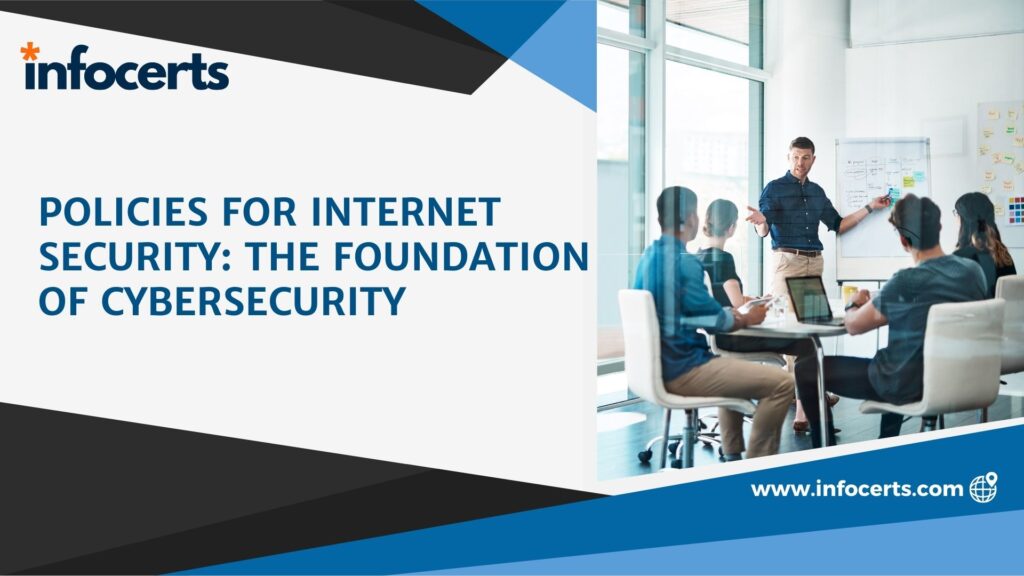In today’s digital age, internet security is paramount for safeguarding sensitive information and maintaining trust. Implementing robust internet security policies forms the cornerstone of effective cybersecurity. Drawing insights from ISO 27032:2023, this blog post explores why these policies are essential, the key components of an effective policy, how to implement and enforce them, and best practices for reviewing and updating them.
Why Internet Security Policies Are Essential
Internet security policies are critical for several reasons:
- Protecting Sensitive Data: Policies help protect personal and organizational data from breaches.
- Ensuring Compliance: They ensure that organizations comply with legal and regulatory requirements.
- Mitigating Risks: Effective policies identify and mitigate potential security threats.
- Building Trust: They help build trust with clients, partners, and stakeholders by demonstrating a commitment to security.
Without these policies, organizations are vulnerable to cyber-attacks, which can lead to financial loss, reputational damage, and legal penalties.
Key Components of an Effective Internet Security Policy
An effective internet security is paramount policy should encompass the following key components:
| Component | Description |
|---|---|
| Access Control | Defines who can access what information and resources. |
| User Authentication | Ensures that only authorized users can access the system. |
| Data Encryption | Protects data in transit and at rest using encryption technologies. |
| Incident Response | Establishes procedures for responding to security incidents. |
| Regular Audits | Conducts regular audits to identify and address vulnerabilities. |
| Employee Training | Provides continuous training to employees on security best practices. |
Detailed Components
- Access Control: Implementing role-based access control (RBAC) ensures that users have access only to the information necessary for their roles.
- User Authentication: Multi-factor authentication (MFA) adds an extra layer of security beyond just passwords.
- Data Encryption: Encrypt sensitive data using protocols like SSL/TLS for data in transit and AES for data at rest.
- Incident Response: Develop a clear incident response plan, including communication protocols and steps for containment and remediation.
- Regular Audits: Schedule regular security audits and vulnerability assessments to keep the security posture up-to-date.
- Employee Training: Regularly train employees on recognizing phishing attempts, proper use of passwords, and reporting suspicious activities.
How to Implement and Enforce Internet Security Policies
Implementing and enforcing internet security is paramount policies involves several steps:
- Develop Clear Policies: Draft clear and comprehensive policies aligned with ISO 27032:2023 guidelines.
- Management Support: Secure support from top management to ensure adequate resources and authority.
- Communication: Communicate policies effectively to all employees and stakeholders.
- Training and Awareness: Conduct regular training sessions to ensure everyone understands and adheres to the policies.
- Monitoring and Enforcement: Use monitoring tools to enforce policies and detect violations.
- Incident Management: Establish a clear procedure for managing and reporting incidents.
Best Practices for Reviewing and Updating Policies
Regularly reviewing and updating internet security policies is crucial to address evolving threats. Here are best practices:
- Periodic Reviews: Conduct policy reviews at least annually or after significant changes in the organization or threat landscape.
- Stakeholder Involvement: Involve stakeholders from various departments to ensure comprehensive coverage.
- Stay Informed: Keep abreast of the latest cybersecurity trends and update policies accordingly.
- Testing and Drills: Regularly test the effectiveness of policies through simulations and drills.
- Feedback Loop: Establish a feedback mechanism for continuous improvement of policies.
Continuous Improvement Cycle
- Assess: Evaluate the current security posture.
- Plan: Identify areas for improvement and plan updates.
- Implement: Roll out updated policies and procedures.
- Review: Monitor the effectiveness and review regularly.
To learn more about implementing robust internet security policies, enroll in our comprehensive ISO 27032:2023 course. Contact us at INFOCERTS at +91 70455 40400.
By adhering to the principles outlined in ISO 27032:2023 and following the steps and best practices discussed, organizations can create a resilient cybersecurity framework that not only protects their assets but also builds lasting trust with their stakeholders. For a detailed guide, check out the ISO 27032:2023 course.

